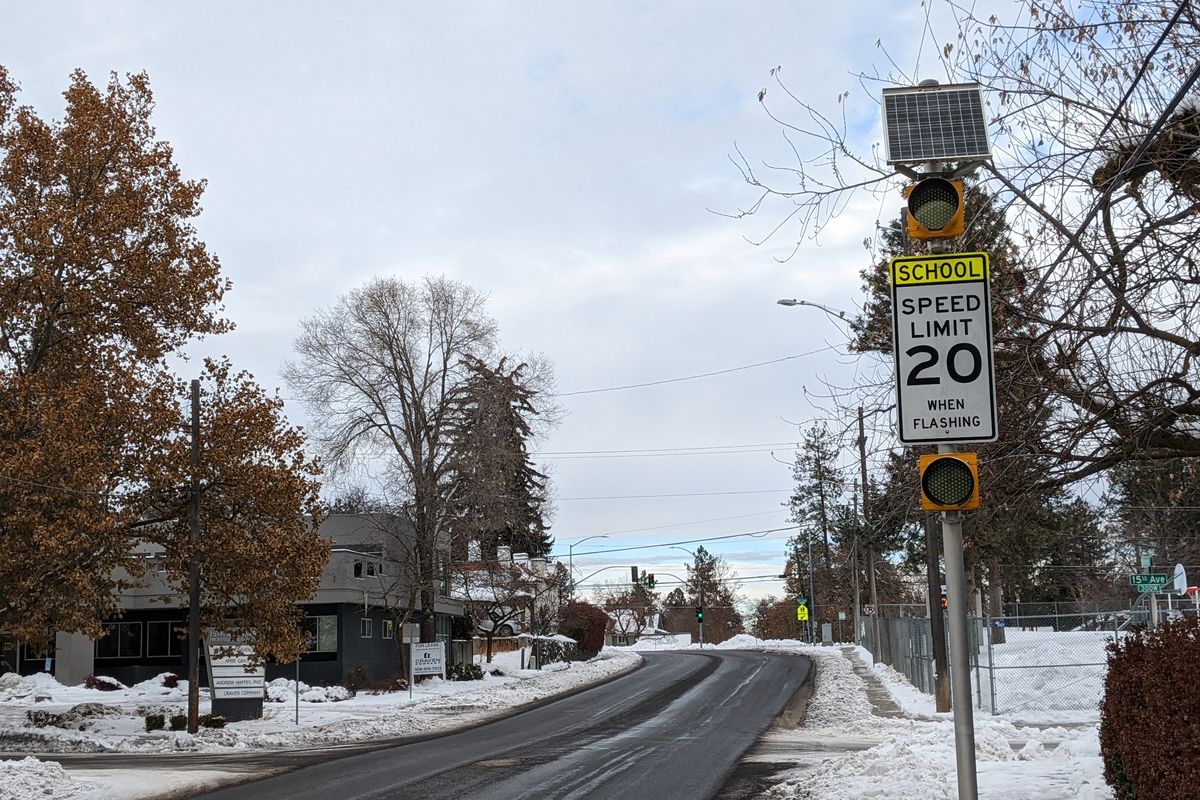Getting There: Spokane’s speeding cameras could more than double next year

By this time next year, Spokane may more than double the number of speeding cameras that ticket drivers and, at least theoretically, convince them to slow down.
The City Council is considering approving the installation of a dozen or more speeding cameras around parks and hospitals, adding to the eight already in operation around some local schools.
The new cameras could begin to be placed as early as September, pending Council approval next year, wrote Council President Breean Beggs in a text message.
Opponents to adding more speeding cameras argue that they do little but generate revenue for the city. Those championing the change, however, say that the cameras will improve public safety and make up for the lack of traffic enforcement personnel.
The push is at least in part prompted by a two-year pilot program that lowered the speed limit on arterial roads bordering parks to 20 mph year-round, instead of just during the summer. That study found that lower speed limits and signage were not enough to slow down speeding drivers.
“At least at some of the parks, people just ignored the speed limit,” Beggs said at a Nov. 28 meeting of the Public Infrastructure, Environment and Sustainability committee.
Speeding cameras may be what are needed to remind drivers to slow down, Beggs added, especially since the Spokane Police Department has disbanded its dedicated traffic enforcement unit and fewer tickets are being given by officers.
The threat of fines could be especially important if speed limits on arterials around parks are permanently lowered to 20 mph, another traffic-calming policy the Council is considering. However, changing the speed limit on arterials would require traffic studies, said city Streets Director Clint Harris.
Rather than add a few cameras at a time, Beggs has proposed adding enough to fully fund a full-time employee who would review the cameras to see if a violation was actually committed.
“We’re just about maxed out for our capacity at municipal court and the police department to process the cameras we have,” Beggs said during the committee meeting. “Rather than just add a couple cameras, which will tip us over into having to have additional staff, we do a suite of them to pay for the (full-time) position.”
Neighborhood councils already have been asked to submit proposals for where the new cameras might be installed. The Manito/Cannon Hill Neighborhood Council submitted a proposal in November for cameras on South Grand Boulevard, East 25th Avenue and South Bernard Street, surrounding Manito Park.
“Apparently, being told to slow down has not been sufficient, and what’s probably going to speak louder than anything else is their pocketbook,” said Mary Winkes, interim chair for the neighborhood council.
Some are skeptical, however, that installing speeding cameras would be about much other than the pocketbooks of drivers.
“I’m not a big fan of red-light or radar-speed cameras,” said former Councilman Mike Fagan. “Basically, like some other citizen’s opinions, it’s just a money grab.”
The cameras are certainly a moneymaker for Spokane. In 2021, infractions caught by school zone cameras resulted in $4,266,415 in fines.
Three new school-zone cameras were installed since this fall: one at Roosevelt Elementary and two covering Ferris High School and Adams Elementary.
Since November, those cameras have begun issuing tickets with fines between $217 and $450.
The city wouldn’t have complete discretion over how to spend new revenue from the speed cameras, however. Like the school -zone cameras, added revenue from park and hospital cameras would go to the dedicated Traffic Calming Program, not the general fund, Beggs said.
Money allocated from that program is intended to complete road work that increases pedestrian safety around town.
Unlike with the speeding cameras in school zones, Spokane would only receive a portion of the fines from those near parks and hospitals.
When the state Legislature earlier this year approved the expansion of automated speeding cameras around parks and hospitals, it also required that cities hand over 50% of the fines to the state’s own traffic safety fund.
Fagan questions whether the existing cameras are functioning as claimed, and whether police officers are a better solution to getting drivers to slow down.
“From what I see continuing to happen, I’d have to say no, I don’t feel as though they are operating as the deterrent as the government originally intended,” he said. “And I would much rather have to deal with a police officer in person than get surprised (by a ticket) in the mail.”
Both might be an option, Beggs said.
If cameras are approved and new revenue starts coming in for calming traffic, Beggs said, it could be argued that those funds should be used to pay for more traffic cops.
Work to watch for
Most street work has wrapped up for the winter.
Both northbound lanes of Market Street in the Hillyard neighborhood are back open as the Washington Department of Transportation continues work on the Children of the Sun Trail.
An all-city snow plow in Spokane was initiated Saturday. The city asks that on-street parkers use the odd side of the street between Nov. 15 and March 15 to aid plowing efforts. Residents are asked to clear a 36-inch path on sidewalks by 9 a.m. after a snowfall.
You can check the progress of the city’s snow plows by visiting my.spokanecity.org/streets/maintenance/snow-removal.
Spokane Valley began an all-city plow on Sunday afternoon, according to a news release. Progress on that plow, which could take more than 48 hours to complete, can also be viewed online at the Spokane Valley website.